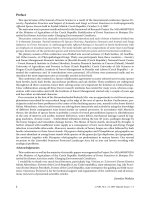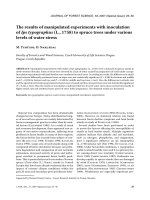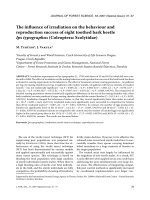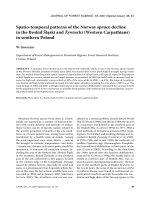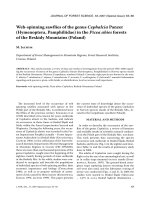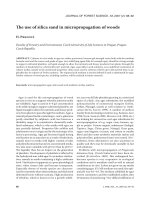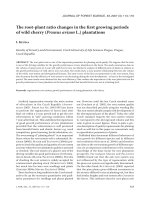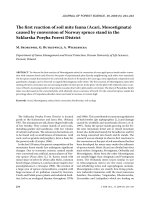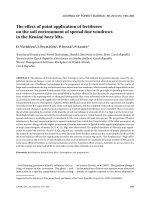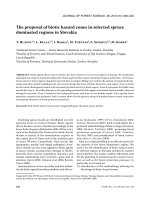Báo cáo lâm nghiệp: "The successional status of tropical rainforest tree species is associated with differences in leaf carbon isotope discrimination and functional traits" pot
Bạn đang xem bản rút gọn của tài liệu. Xem và tải ngay bản đầy đủ của tài liệu tại đây (315.08 KB, 8 trang )
Ann. For. Sci. 64 (2007) 169–176 169
c
INRA, EDP Sciences, 2007
DOI: 10.1051/forest:2006101
Original article
The successional status of tropical rainforest tree species
is associated with differences in leaf carbon isotope discrimination
and functional traits
Damien B
a
*
, Céline B
a
, Claude B
b
,SabrinaC,EricM
a
,
Jean-Christophe R
a
, Jean-Marc G
b
a
INRA Kourou, UMR Écologie des Forêts de Guyane, BP 709, 97387 Kourou Cedex, Guyane, France
b
INRA Nancy, UMR Écologie et Écophysiologie, 54280 Champenoux, France
(Received 24 April 2006; accepted 30 June 2006)
Abstract – We characterised the among species variability in leaf gas exchange and morphological traits under controlled conditions of seedlings of
22 tropical rainforest canopy species to understand the origin of the variability in leaf carbon isotope discrimination (∆) among species with different
growth and dynamic characteristics (successional gradient). Our results first suggest that these species pursue a consistent strategy in terms of ∆
throughout their ontogeny (juveniles grown here versus canopy adult trees from the natural forest). Second, leaf ∆ was negatively correlated with WUE
and N, and positively correlated with g
s
, but among species differences in ∆ were mainly explained by differences in WUE. Finally, species belonging
to different successional groups display distinct leaf functional and morphological traits. We confirmed that fast growing early successional species
maximise carbon assimilation with high stomatal conductance. In contrast, fast and slow growing late successional species are both characterised by
low carbon assimilation values, but by distinct stomatal conductance and leaf morphological features. Along the successional gradient, these differences
result in much lower ∆ for the intermediate species (i.e. fast growing late successional) as compared to the two other groups.
13
C / functional diversity / leaf gas exchange / species gr ouping / tropical rainfor est
Résumé – Le statut successionnel des espèces de la forêt tropicale humide est associé à des différences de discrimination isotopique du carbone
et de traits fonctionnels foliaires. Nous avons caractérisé la variabilité interspécifique des échanges gazeux et des traits morphologiques foliaires en
conditions environnementales contrôlées de jeunes plants de 22 espèces d’arbres de la canopée en forêt tropicale humide afin de comprendre l’origine
de la variabilité de la discrimination isotopique du carbone foliaire (∆) observée entre ces espèces présentant des caractéristiques de croissance et de
dynamique distinctes (groupes successionnels). Nous montrons premièrement que les espèces tropicales possèdent une stratégie très conservée de ∆
au cours de leur ontogénie (juvéniles élevés ici versus arbres adultes de la canopée en forêt naturelle). Deuxièmement, ∆ était négativement corrélée
à WUE et N, et positivement à g
s
, mais les différences de ∆ entre espèces sont principalement expliquées par des différences de WUE. Enfin, nous
montrons que les espèces appartenant à des groupes successionnels distincts présentent des traits fonctionnels et morphologiques foliaires distincts.
Nous confirmons que les espèces à croissance rapide qui s’installent en premier au cours de la succession écologique (FE) maximisent A avec de fortes
conductances stomatiques. Les espèces climax (qui s’installent en second dans la succession écologique), à croissance rapide (FL) ou à croissance
faible (SL), présentent des valeurs de A identiques, mais des valeurs de g
s
ainsi que des caractéristiques morphologiques foliaires distinctes. Dans la
succession écologique, ces différences se traduisent par des valeurs de ∆ nettement plus faibles pour les espèces intermédiaires (c’est-à-dire les espèces
climax à croissance rapide) par rapport aux deux autres groupes.
13
C / diversité fonctionnelle / échanges gazeux foliaires / groupes successionnels / forêt tropicale humide
1. INTRODUCTION
In an attempt to simplify the complexity of the tropical
rainforest ecosystem and to understand the mechanisms un-
derlying the coexistence and distribution of the numerous tree
species, forest ecologists have tried to group species according
to ecological traits [3, 15, 39,50,55,58]. A continuum of trait
values, rather than distinct classes, is usually found and the
chance to find a single clustering of species based on several
ecological traits is small. However, classifications combining
at least two ecological axes have been proposed [22,24,39,55].
These axes can be characterised by the dynamic of the forest
* Corresponding author:
(tree growth, mortality and recruitment) and the morphology
of trees (height and maximal diameter of the trees) and are
pertinent to understand ecosystem processes [38].
Distinct leaf functional and/or morphological traits have
been found among successional groups in neotropical rain-
forests [3, 6, 15, 16, 30, 42, 44, 49]. Comparisons between fast
growing early successional species (FE) and late successional
species at a whole have been widely conducted. Higher spe-
cific leaf area (SLA), leaf dry mass based nitrogen concen-
tration values (N) or maximum photosynthetic characteristics
(A) are generally found in the former ones. In contrast, com-
parisons within the late successional group (fast growing late
successional, FL, versus slow growing late successional, SL)
Article published by EDP Sciences and available at or />170 D. Bonal et al.
are more scarce. Whereas no significant differences in photo-
synthetic capacities among these two groups were observed in
a common garden experiment [10], higher values of A and N
were found in FL species (defined as “intermediate”) as com-
pared to SL ones in an in situ experiment on saplings in BCI,
Panama [15]. Furthermore, sunlit leaf carbon isotope discrim-
ination (∆) of adult trees was lower in FL species as compared
to SL and FE species in different tree communities in French
Guiana [7,26], underlying an original non-linear distribution
(modal distribution) of this trait along the successional gra-
dient. Carbon isotope discrimination (∆) – roughly the differ-
ence in carbon isotope composition (∆
13
C) between the carbon
source for photosynthesis (i.e. atmospheric CO
2
) and the pho-
tosynthetic products (i.e. leaf material) – is a convenient mea-
sure of long-term intercellular CO
2
concentration [19–21]. It
constitutes an indicator of the set point for leaf gas exchange
regulation, reflecting leaf-level water-use efficiency (WUE)
and overall trade-offs between carbon gain and transpirational
water loss [13]. The physiological basis for these differences
in ∆ among successional groups has not yet been elucidated.
While screening tree communities in the tropical rainfor-
est of French Guiana, variations in sunlit leaf ∆ of up to
6.5% have been found within 1-ha stands [7]. This varia-
tion reflects a threefold variation in WUE among species.
WUE is defined as the ratio of net carbon assimilation rate
(A) to stomatal conductance for water vapour (g
s
). Yet it re-
mains unclear whether estimates of ∆-derived WUE are re-
lated to differences in A or g
s
, or merely reflect differences
in the trade-off between these variables [13, 21]. A large vari-
ability in such leaf gas exchange characteristics has been ob-
served among juveniles of tropical rainforest species, with up
to a four-fold range among species within the same environ-
ment [3, 6, 9, 15–17, 29, 30, 32, 37, 54]. Furthermore, based
on observations on seven species growing under homogenous
conditions in monospecific plantations, it has been suggested
that differences in ∆ among tropical rainforest tree species
were mainly related to differences in g
s
[26]. Species with low
∆ values presented low g
s
values, while A values were inter-
mediate. We question here whether species belonging to dif-
ferent successional groups and differing in ∆ would display
different leaf gas exchange (A, g
s
, WUE) and leaf morpholog-
ical traits. In particular, we address the following questions:
– Are differences among species in ∆ consistent over onto-
genetic stages (juvenile versus adult)?
– Is the among species variability in ∆ in tropical rainforests
related to differences in leaf gas exchange (A, g
s
, or merely
the ratio A/g
s
= WUE) and with other related leaf traits?
– Are species belonging to different successional groups
(FE, FL, SL) characterised by different leaf morphologi-
cal and/or functional characteristics, particularly ∆, under
common environmental conditions?
2. MATERIALS AND METHODS
2.1. Plant material
In situ comparative leaf gas exchange measurements on numer-
ous adult trees under similar environmental conditions are not fea-
sible. Then, in this study, potted seedlings of 22 abundant canopy
tree species of the rainforest of French Guiana were grown in a
glasshouse under common environmental conditions. The 22 focal
species represented a broad range of in situ leaf ∆ ([7], and Bonal,
unpublished data) and were classified into three successional groups
with regard to growth and dynamic characteristics according to Favri-
chon [22, 23]. This grouping is based on a statistical analysis of tree
dynamic (growth, mortality and recruitment) and morphological and
dendrometric (height and maximal diameter of the trees) variables
at the adult and sub-adult stage and a PCA analysis leading to two
axes related to potential size and heliophily. The three groups are
fast growing early successional (FE), fast growing late successional
(FL), and slow growing late successional (SL), with mean canopy
tree annual diameter increments equal to 0.27 ± 0.04, 0.24 ± 0.03,
and 0.13 ± 0.01 cm year
−1
, respectively [22, 23]. SL species regen-
erate and develop in the understory and retain low diameter growth
rates even once installed in the canopy. In contrast, FL species display
higher growth rates in the large diameter classes than in the small di-
ameter ones. For species not included in these analyses, the succes-
sional group was assigned based on Béna [4]. No such information
was found for Eriotheca.
Fifty seeds per species were collected from within a 10-m radius
of each of at least five adult trees per species in the Paracou for-
est, French Guiana (5˚ 16’ N, 52˚ 55’ W) in spring 2000, except
for Cecropia and Talisia for which seeds were collected in the sur-
roundings of Kourou, French Guiana. Randomly selected germinated
seedlings (15–20 per species) were kept for 18 months in 5.3-L black
polyethylene containers filled with a homogenised forest soil in a
shaded understory site (about 16% full sun). In September 2001, 10–
12 seedlings per species were transplanted into 20-L plastic pots and
randomly distributed in a glasshouse in Kourou, French Guiana. One
layer of neutral shade-cloth was used to reduce light levels to about
25% of full sun (maximum PAR ≈ 500 µmol m
−2
s
−1
). Pots were filled
with a mixture of sand (30%) and an A-horizon soil (70%) from the
Paracou forest. Plantlets were grown for eight months, during which
they were watered every two days in order to match the amount of wa-
ter observed to have been lost through evapotranspiration and then to
maintain plants at field capacity (≈ 0.25 m
3
m
−3
). Soil water content
in the pots was recorded monthly using a TDR Trime FM2 (Imko,
Ettlingen, Germany). Pots were fertilised every second month (5 g
complete fertiliser per pot, 12/12/17/2N/P/K/Mg) and treated with a
commercial insecticide (Cuberol: 5% rotenone).
2.2. Leaf gas exchange, leaf and plant traits
In April 2002, leaf gas exchange measurements were conducted
on 7–11 plants per species using a portable photosynthesis system
(CIRAS1, PP-Systems, Hoddesdon, UK) operating in open mode and
fitted with a Parkinson leaf cuvette. Gas exchange measurements
were conducted on two leaves per plant under the following non-
limiting environmental conditions [10]: [CO2] = 360 ppm; PAR =
670 ± 20 µmol m
−2
s
−1
; vapour pressure deficit = 1.2 ± 0.4kPa;
air temperature = 30.0 ± 2.1 ˚C. Equations of Caemmerer and
Farquhar [8] were used to calculate net carbon assimilation rate on
a leaf area (A, µmol m
−2
s
−1
)ormass(A
m
, mmol g
−1
s
−2
)basis,
stomatal conductance for water vapour (g
s
,molm
−2
s
−1
) and intrin-
sic water-use efficiency (WUE = A/g
s
). After the gas exchange mea-
surements, 10 to 15 mature and fully expanded leaves per plant were
collected in order to characterise specific leaf area (SLA, cm
2
g
−1
)
and leaf thickness (LT, µm) and calculate leaf density (LD = 1 / (SLA
Leaf trait diversity in tropical species 171
× LT), g cm
−3
). The leaves were then dried for 48 h at 70.0 ˚C and
finely ground.
2.3. Carbon, nitrogen and isotope analyses
A sub-sample of 10
−3
g of dry leaf powder was analysed for total
carbon (C, %) and nitrogen (N,mgg
−1
) concentration (ThermoQuest-
NA-1500-NCS, Carlo Erba, Italy) at the stable isotope facility of
INRA Nancy, France. Leaf carbon isotope composition (δ
13
C) for
each plant was estimated on the same sub-sample using an isotope
ratio mass spectrometer (Delta-S Finnigan Mat, Bremen, Germany).
Glasshouse air carbon isotope composition (δ
a
= −7.85%) was es-
timated using leaf carbon isotope composition (δ
13
C) of corn grown
for four months during the acclimation phase in the glasshouse [35].
Leaf carbon isotope discrimination (∆) was calculated as:
∆=
δ
a
− δ
13
C
1 + 0.001 × δ
13
C
· (1)
∆ is theoretically related with WUE (= A/g
s
) through the following
equation [19]:
∆=b −
1.6 × (b − a) × WUE
C
a
, (2)
where C
a
is the CO
2
concentration in air, and a and b are fractionation
factors during the diffusion of CO
2
through the stomata and during
photosynthetic carboxylation, respectively, that are assumed here to
be constant for all species.
2.4. Ontogenetic test
To compare leaf ∆ of seedlings grown in the glasshouse (original
data of this study) with that of sunlit leaves of mature canopy trees,
we compiled ∆ data from two 1-ha stands (Saint-Elie [7], and Bafog,
Bonal, unpublished data) in French Guiana. These two stands com-
prised 3–9 mature and dominant trees characterised for leaf ∆ for 14
species out of the 22 studied species in the glasshouse (Tab. I). For
more details on data collecting protocol, see Bonal et al. [7].
2.5. Statistical analyses
Statistical analyses were performed using SAS programs (SAS-
Institute, Cary, USA). Differences among species for the different
parameters were tested using ANOVA in the general linear regres-
sion model (GLM) procedure. Correlations between the different pa-
rameters were tested using Pearson’s correlation coefficients. The re-
lationship between ∆ and WUE was tested using a general linear
regression model. As both sets of juvenile and adult ∆ data were sub-
jected to measurements errors, a model II regression analysis was
performed to test for any relationship between glasshouse and forest
values among the 14 species. Statistical differences among succes-
sional groups were tested using an ANOVA and post-hoc Duncan’s
multiple range tests.
Figure 1. The relationship between leaf carbon isotope discrimina-
tion (∆) and intrinsic water-use efficiency (WUE = A/g
s
) for pot-
ted seedlings of 22 tropical rainforest species grown in non-limiting
environmental conditions in a glasshouse (n = 7to11plantsper
species). The theoretical relationship is represented by the dotted line
(∆=−0.095 × WUE + 27.00) [21]. Vertical and horizontal bars de-
note ± 1 standard error of the species mean. The grey lines represent
the upper and lower confidence interval limits (95%) of the relation-
ship between ∆ and WUE. The Symbols correspond to the succes-
sional groups: white squares correspond to fast growing early suc-
cessional species (FE); grey triangles correspond to fast growing late
successional species (FL); black dots correspond to slow growing late
successional species (SL); the star corresponds to an undetermined
species.
3. RESULTS
Mean species ∆ varied from 18.6 to 24.0%, with low
within species variability (Fig. 1). WUE, SLA and N varied
over a twofold range (Fig. 1, Tab. I). A, g
s
and LD varied over
a threefold range.
For the significant statistical correlations obtained among
measured parameters (Tab. II), we underline that A or A
m
were significantly correlated with all parameters except ∆ and
WUE. ∆ was negatively correlated with WUE and g
s
and pos-
itively with N. WUE and g
s
were strongly negatively corre-
lated.
The relationship between ∆ and WUE was highly signif-
icant (Fig. 1). This relationship was not statistically differ-
ent from the one described by the theory since the slope and
the y-intercept of the theoretical line (–0.095 and 27.00, re-
spectively) fell in the confidence interval (95%) of the slope
(−0.084 ± 0.024) and the y-intercept (26.87 ± 1.56) of the re-
lationship between ∆ and WUE.
There was a strong positive and linear relationship between
∆ of sunlit leaves of dominant canopy trees and the leaves of
potted seedlings of the same species grown in the glasshouse
(P < 0.01) (Fig. 2).
There was a significant group effect on all studied traits
(Fig. 3) except LD (P = 0.23). FE species had highest values
in A
m
,A,g
s
,NandSLA.Therewasnodifference in A
m
or A
172 D. Bonal et al.
Table I. Mean (± SE, n = 7− 11) of specific leaf area (SLA, cm
2
g
−1
), leaf density (LD, g cm
−3
), leaf carbon concentration (C, %), and nitrogen
concentration on a dry mass basis (N, mg g
−1
) of the 22 studied species. Species are sorted according to successional groups (FE = fast growing
early successional, FL = fast growing late successional, SL = slow growing late successional, Und. = Undetermined). * Symbol indicates that
this species was included in the juvenile versus adult comparison. Groups’ effect was tested using an ANOVA and post-hoc Duncan’s multiple
range test (P < 0.05). Species named according to Boggan et al. [5].
Species name Taxonomic
family
Group SLA
cm
2
g
−1
LD
gcm
−3
C
%
N
mg g
−1
Bagassa guianensis J.B. Aublet Moraceae FE 255.6 ± 48.5 0.18 ± 0.02 46.3 ± 1.8 24.9 ± 1.7
* Carapa procera A.P. De Candolle Meliaceae FE 158.6 ± 6.6 0.30 ± 0.01 48.2 ± 0.2 17.9 ± 0.6
* Cecr opia obtusa Trécul Moraceae FE 215.1 ± 9.6 0.19 ± 0.01 47.2 ± 0.4 21.1 ± 1.5
Hymenaea courbaril Linnaeus Caesalpiniaceae FE 199.8 ± 32.0 0.34 ± 0.04 48.6 ± 0.6 24.8 ± 0.9
Tabebuia insignis Sandwith Bignoniaceae FE 138.9 ± 5.9 0.31 ± 0.02 48.4 ± 0.3 21.4 ± 1.3
* Virola michelii Heckel Myristicaceae FE 129.1 ± 5.5 0.45 ± 0.01 49.8 ± 0.3 18.5 ± 0.6
Virola surinamensis Warburg Myristicaceae FE 142.9 ± 5.5 0.33 ± 0.02 51.6 ± 0.3 23.1 ± 0.5
* Dicorynia guianensis G.J. Amshoff Caesalpiniaceae FL 188.5 ± 10.4 0.27 ± 0.02 51.1 ± 0.3 19.8 ± 0.9
* Eperua falcata J.B. Aublet Caesalpiniaceae FL 140.6 ± 5.0 0.43 ± 0.00 50.9 ± 0.4 23.7 ± 0.9
* Eperua grandiflora Bentham Caesalpiniaceae FL 117.0 ± 13.2 0.44 ± 0.00 49.6 ± 0.3 20.3 ± 1.2
* Sextonia rubra Lauraceae FL 107.1 ± 6.2 0.36 ± 0.01 50.1 ± 0.4 11.5 ± 0.6
Talisia furfuracea Sandwith Sapindaceae FL 208.6 ± 9.3 0.34 ± 0.04 48.4 ± 0.3 21.8 ± 0.7
Amanoa guianensis J.B. Aublet Euphorbiaceae SL 112.6 ± 6.0 0.35 ± 0.02 47.4 ± 1.2 15.0 ± 1.1
* Aspidosperma album R. Benoist Apocynaceae SL 142.9 ± 7.7 0.31 ± 0.02 49.0 ± 0.8 14.4 ± 1.4
* Eschweilera sagotiana Miers Lecythidaceae SL 101.0 ± 5.1 0.36 ± 0.03 49.3 ± 0.3 15.6 ± 0.9
* Lecythis persistens Sagot Lecythidaceae SL 107.0 ± 7.5 0.37 ± 0.03 50.9 ± 0.2 15.7 ± 0.8
* Licania heter omorpha Bentham Chrysobalanaceae SL 102.0 ± 7.5 0.41 ± 0.03 48.5 ± 0.7 10.4 ± 0.8
* Manilkara bidentata A.J. Chevalier Sapotaceae SL 94.9 ± 8.5 0.32 ± 0.02 47.6 ± 1.2 11.7 ± 0.9
Poraqueiba guianensis J.B. Aublet Icacinaceae SL 100.4 ± 5.5 0.37 ± 0.02 49.2 ± 0.3 10.7 ± 0.5
* Pr otium subseratum Engler Burseraceae SL 154.8 ± 10.9 0.35 ± 0.03 47.5 ± 0.2 14.4 ± 0.5
* Vouacapoua americana J.B. Aublet Caesalpiniaceae SL 161.8 ± 4.4 0.45 ± 0.01 51.5 ± 0.4 18.6 ± 0.6
Eriotheca sp. Bombacaceae Und. 98.2 ± 5.9 0.25 ± 0.01 46.0 ± 0.3 15.9 ± 0.7
ANOVA-Test for group effect P < 0.001 P = 0.230 P < 0.001 P < 0.001
between FL and SL species. In contrast, N, C and SLA were
significantly higher in FL species as compared to FE ones, and
g
s
was lower in FL species as compared to FE ones. FL species
displayed significantly higher WUE and lower ∆ as compared
to FE and SL species, which did not differ.
4. DISCUSSION
4.1. Functional diversity
This study confirmed the high variability of leaf morpho-
logical [46, 56] and functional [6, 15, 17, 29, 30, 32, 46] traits
among tropical rainforest species. In common environmen-
tal conditions, we observed differences on a two-to-three-fold
range among species in leaf gas exchange, WUE, and leaf mor-
phological characteristics, whereas the within species variabil-
ity of these traits under homogenous conditions remains low
(Tab.I,Fig.1).
The relationship between time-integrated ∆ and instanta-
neous WUE at the species level (∆=−0.084 × WUE + 26.87;
P < 0.01; R
2
= 0.37) was in agreement with the two-step car-
bon isotope discrimination model [19] (∆=−0.095 × WUE +
27.00) (Fig. 1). The relationship for some species slightly de-
viated from the theoretical line. As already discussed by other
authors [19, 41], the difference in time-integration scale be-
tween the two variables could be one major cause for this dis-
crepancy. Whereas WUE was derived from spot measurements
of instantaneous leaf gas exchange, ∆ was estimated based on
leaf carbon isotope composition that are integrated over the
lifetime of the analysed leaf tissue (9 to 24 months). Other
causes related to differences in morphology and structure of
the leaves of these species (leaf density, specific leaf area,
Tab. I) must be considered as well [20, 28, 40]. These differ-
ences could lead to distinct values of internal conductance to
diffusion of CO
2
from the intercellular air spaces to the sites
of carboxylation and then to internal isotopic fractionation fac-
tors differing among species [18]. Furthermore, recent papers
Leaf trait diversity in tropical species 173
Leaf
∆
of glasshouse juveniles
Leaf
∆
of forest trees
18
20
22
24
26
18 20 22 24 26
y = 1.28 x – 7.76
P < 0.01 ; R
2
= 0.61
y = 1.28 x – 7.76
P < 0.01; R
2
= 0.61
Figure 2. The relationship (Model II regression) between mean
species leaf ∆ values (n = 14) of seedlings grown in the glasshouse
and of canopy trees from two forest stands in French Guiana. For
the seedlings, species mean is based on 7–11 plants. For the adult
trees, species mean is based on 3–9 trees. Vertical and horizontal bars
denote ± 1 standard error of the mean. Symbols correspond to the
successional groups: white squares correspond to fast growing early
successional species (FE); grey triangles correspond to fast growing
late successional species (FL); black dots correspond to slow growing
late successional species (SL).
Table II. Pearson correlation coefficients among morphological and
functional parameters for the 22 studied species: leaf-area based rates
of net carbon assimilation (A, µmol m
−2
s
−1
), leaf-mass based rates of
net carbon assimilation (A
m
, µmol s
−1
g
−1
), stomatal conductance for
water vapour (g
s
,molm
−2
s
−1
), intrinsic water-use efficiency (WUE =
A/g
s
), leaf carbon isotope discrimination during photosynthesis (∆),
leaf carbon concentration (C, %), leaf nitrogen concentration on a dry
mass basis (N, mg g
−1
), specific leaf area (SLA, cm
2
g
−1
), and leaf
density (LD, g cm
−3
). Numbers in bold indicate significant correla-
tion at P = 0.05.
A
m
g
s
WUE ∆ CNSLALD
A 0.63 0.79 0.07 –0.03 –0.23 0.36 0.23 –0.41
A
m
0.62 –0.17 0.23 –0.24 0.49 0.79 –0.58
g
s
–0.49 0.24 –0.29 0.11 0.27 –0.47
WUE –0.51 0.19 0.37 –0.10 0.29
∆ –0.06 –0.31 0.11 0.04
C 0.12 –0.07 0.37
N 0.51 –0.05
SLA –0.53
pointed to variable isotopic fractionations during dark respira-
tion (e.g. [51]) or post-photosynthetic fractionations [1]. These
fractionations, that are not included in the simple model of
discrimination described in [19] and used here, could differ
among species and contribute to the shift with the theoretical
line.
Figure 3. The mean values (± 1 SE) of mass-based carbon net assim-
ilation (A
m
), leaf area-based carbon net assimilation (A), leaf nitro-
gen concentration on a dry mass basis (N), stomatal conductance for
water vapour (g
s
), leaf carbon concentration (C), intrinsic water-use
efficiency (WUE = A/g
s
), specific leaf area (SLA), and leaf carbon
isotope discrimination (∆) for each successional groups (FE = fast
growing early successional, FL = fast growing late successional, SL =
slow growing late successional) for potted seedlings of 22 species of
the rainforest of French Guiana grown in a glasshouse under non-
limiting environmental conditions. For a given trait, means followed
by the same letter are not significantly different at P = 0.05 (Duncan’s
multiple range test).
When grown in pots under homogeneous environmental
conditions, the 22 focal species almost covered the entire gra-
dient in ∆ observed in 1-ha stands of natural forest for mature
trees (5.4 ) [7, 26]. Furthermore, a significant correlation be-
tween ∆ of 2-year old seedlings and canopy trees was found
(∆
juvenile
= 1.28 × ∆
adult
− 7.76; P < 0.01; R
2
= 0.61, Fig. 2)
and then an overall consistent species ranking. Several stud-
ies demonstrated ontogenetic shifts for functional traits such
as biomass allocation, SLA or A for tropical [36, 43, 53] or
temperate (e.g. [11]) species, whereas no such shift was ob-
served for hydraulic traits for Patagonian conifers [27]. Our
results support the statement that among species differences in
174 D. Bonal et al.
the metabolic intrinsic set point for the trade-off between car-
bon and water fluxes at the leaf level, as reflected by ∆ [13], are
maintained over the lifetime of these species. Except for one
species, leaf ∆ of glasshouse seedlings were lower (1.5% on
average) than values of adult trees (Fig. 2), which can be in-
terpreted as a higher WUE for juveniles as compared to trees
(see Eq. (1)). These differences can be mainly explained by the
differences in environmental conditions (i.e. light, air tempera-
ture and humidity, CO
2
concentration) encountered by the two
considered sets of values. These conditions are recognised to
strongly influence ∆ (see synthesis in [14]). Furthermore, iso-
tope fractionations come into play during carbohydrate storage
and translocation, or when leaf tissues are partially constructed
from stored carbohydate reserves, as for adult trees [52].
4.2. Association of traits
Previous studies on trade-offs among leaf traits concen-
trated mainly on traits related to carbon assimilation, leaf
structure or chemical concentrations [45,46, 56,57]. Leaf car-
bon traits of tropical rainforest seedlings studied here were in
agreement with general trade-offs since carbon assimilation
increases with increasing N and SLA, and decreases with in-
creasing C and LD (Tab. II). It has been suggested that includ-
ing additional traits related to water relations (e.g. leaf con-
ductance to water vapour) in these approaches may improve
our understanding of plant function [48, 57]. We present here
evidence that other associations of traits at the leaf level do ex-
ist among tropical rainforest species with regard to carbon iso-
tope discrimination and stomatal regulation (Tab. II). Higher ∆
are associated with lower WUE and g
s
, and higher N. Further-
more, higher A or A
m
are strongly associated with g
s
.These
data suggest that biophysical and natural selection constraints
result in the exclusion of some combinations between transpi-
rational fluxes and leaf structure or carbon concentrations. In-
cluding these functional traits in larger meta-analyses on leaf
economics may therefore allow improvements of the interpre-
tation of functional differences among tropical rainforest tree
species.
In order to understand the origin of the strong variabil-
ity in ∆ among species, we compared the leaf gas exchange
and morphological traits of these species. Differences among
species in ∆ were not accounted for by differences in photo-
synthetic characteristics, but rather by differences in g
s
and
WUE (Tab. II, Fig. 1), in agreement with previous observa-
tions on tropical rainforest species [6, 26]. However, although
the relationship between ∆ and g
s
was statistically significant
(Tab. II), g
s
explained only a very small part of the variabil-
ity in ∆ among species (R
2
= 0.08). In contrast, WUE ex-
plained 37% of this variability (Fig. 1). Therefore, we suggest
that it is the compromise between carbon fluxes and stomatal
conductance for water vapour, i.e. WUE, rather than A or g
s
,
that is the main determinant for the differences among trop-
ical rainforest species in ∆ (Fig. 1). High ∆ in some species
are associated with low WUE, and vice versa. Such compar-
ative studies on a large number of tropical rainforest species
have not yet been conducted. Nevertheless, correlations be-
tween ∆ and A or g
s
have been observed in other forested
ecosystems, with contrasting patterns. Differences in ∆ among
evergreen species from Japanese warm-temperate forests were
not caused by the variation in g
s
, but mainly by the difference
in long-term photosynthetic capacity [28]. The variability in
WUE among Caribbean hybrid Pine clones was also mainly
attributed to differences in photosynthetic capacity rather than
in stomatal conductance [59].
4.3. Differences among groups
Our results pointed to significant differences in ∆, leaf gas
exchange, and leaf characteristics among seedlings of species
belonging to different successional groups (Fig. 3) that are
consistent with other studies (e.g. [3, 15,30,32]).
Fast growing early successional species (FS) tend to max-
imise carbon assimilation rates (highest A) with stomata
widely open (highest g
s
) for high transpiration rates. This strat-
egy is associated with higher SLA, N, A
m
,Aorg
s
values than
those of the late successional species, and high ∆ (21.9) and
low WUE (60.5 µmol mol
−1
). Furthermore, we present evi-
dence for the existence of two distinct groups within the late
successional species (fast growing versus slow growing) with
regard to leaf functional and morphological traits, support-
ing previous studies under natural conditions [15]. The two
groups are characterised by non-significantly different carbon
assimilation rates (A
m
or A), but FL species have lower g
s
and
higher SLA, C and N than SL species (Fig. 3). Furthermore,
the strategy of the FL species in the trade-off between A and
g
s
seems to be associated with much lower ∆ (20.2%)val-
ues than SL ones (22.3%). The observed differences among
these groups in ∆ seem to be environmentally stable since our
results for seedlings grown in a glasshouse are in agreement
with previous studies on sunlit leaves of forest trees under nat-
ural conditions [7,26]. These functional differences seem to be
consistent with the suggested adaptations of tropical rainforest
species to the numerous and complex ecological niches related
to light and water acquisition [47].
In contrast with most leaf functional traits, we demonstrated
here the absence of a linear distribution in ∆,WUEandC
along the successional gradient (Fig. 3). Despite large dif-
ferences in leaf gas exchange and morphological characteris-
tics, FE and SL species display non-significantly different ∆,
WUE and C values, whereas species with the lowest ∆ (high-
est WUE) have an intermediate position along the successional
gradient. The lowest ∆ (i.e. highest WUE and low g
s
) observed
for these species might be associated with a better ability to
compete under high water vapour pressure deficit [2,34] such
as in the upper canopy layer, and/or under low soil water con-
ditions [12, 31, 33, 41] such as during the seasonal dry sea-
son encountered in French Guiana [25]. Whether this peculiar
‘V shaped’ pattern of relationship between ∆ and the position
within the successional gradient of species holds in other for-
est biomes is a worthy question.
Leaf trait diversity in tropical species 175
Acknowledgements: The authors wish to express their deep thanks
to Jean-Yves Goret and Elli Lentilus, INRA Kourou, for their pre-
cious contribution to this experiment, to Chris Baraloto who provided
the seedlings, and Tancrede Almeras for his help in the data analysis.
We also thank two anonymous reviewers who greatly enhanced the
first manuscript.
REFERENCES
[1] Badeck F. W., Tcherkez G., Nogue S., Piel C., Ghashghaie J.,
Post-photosynthetic fractionation of stable carbon isotopes between
plant organs – a widespread phenomenon, Rapid. Commun. Mass
Spectrom. 19 (2005) 1381–1391.
[2] Barbour M.M., Farquhar G.D., Relative humidity- and ABA-
induced variation in carbon and oxygen isotope ratios of cotton
leaves, Plant Cell Environ. 23 (2000) 473–485.
[3] Bazzaz F.A., Picket S.T.A., Physiological ecology of a tropical suc-
cession: a comparative review, Annu. Rev. Ecol. Syst. 11 (1980)
287–310.
[4] Béna P., Essences forestières de Guyane, Imprimerie Nationale,
1960.
[5] Boggan J., Funk V., Kelloff C., Hoff M., Cremers G., Feuillet C.,
Checklist of the plants of the Guianas: Guiana, Surinam, French
Guiana, Georgetown, Guyana, 1997.
[6] Bonal D., Barigah T.S., Granier A., Guehl J M., Late stage canopy
tree species with extremely low δ
13
C and high stomatal sensitivity
to seasonal soil drought in the tropical rainforest of French Guiana,
Plant Cell Environ. 23 (2000) 445–459.
[7] Bonal D., Sabatier D., Montpied P., Tremeaux D., Guehl J
M., Interspecific variability of δ
13
C among canopy trees in rain-
forests of French Guiana: Functional groups and canopy integration,
Oecologia 124 (2000) 454–468.
[8] Caemmerer S. von, Farquhar G.D., Some relationships between
the biochemistry of photosynthesis and the gas exchange rates of
leaves, Planta 153 (1981) 376–387.
[9] Cao K.F., Water relations and gas exchange of tropical saplings dur-
ing a prolonged drought in a Bornean heath forest, with reference
to root architecture, J. Trop. Ecol. 16 (2000) 101–116.
[10] Coste S., Roggy J C., Imbert P., Born C., Bonal D., Dreyer E., Leaf
photosynthetic traits of 14 tropical rain forest species in relation to
leaf nitrogen concentration and shade tolerance, Tree Physiol. 25
(2005) 1127–1137.
[11] Covone F., Gratani L., Age-related physiological and structural
traits of chestnut coppices at the Castelli Romani park (Italy), Ann.
For. Sci. 63 (2006) 239–247.
[12] Cowan I.R., Economics of carbon fixation in higher plants, in:
Givnish T.J. (Ed.), On the economy of plant form and function,
Cambridge University Press, Cambridge, 1986, pp. 133–170.
[13] Ehleringer J.R., Gas exchange implications of isotopic variation
in arid-land plants, in: Smith J.A.C., Griffiths H. (Eds.), Water
deficits. plant responses from cell to community, Environmental
Plant Biology Series, Lancaster, UK, 1993, pp. 265–284.
[14] Ehleringer J.R., Hall A.E., Farquhar G.D., Stable isotopes and
plant-carbon water relations, Academic Press Inc., 1993.
[15] Ellis A.R., Hubbell S.P., Potvin C., In situ field measurements of
photosynthetic rates of tropical tree species: a test of the functional
group hypothesis, Can. J. Bot. 78 (2000) 1336–1347.
[16] Ellsworth D.S., Reich P.B., Photosynthesis and leaf nitrogen in five
Amazonian tree species during early secondary succession, Ecology
77 (1996) 581–594.
[17] Engelbrecht B.M.J., Wright S.J., De Steven D., Survival and eco-
physiology of tree seedlings during El Nino drought in a tropical
moist forest in Panama, J. Trop. Ecol. 18 (2002) 569–579.
[18] Evans J.R., Sharkey T.D., Berry J.A., Farquhar G.D., Carbon iso-
tope discrimination measured concurrently with gas exchange to
investigate CO
2
diffusion in leaves of higher plants, Aust. J. Plant
Physiol. 13 (1986) 281–292.
[19] Farquhar G.D., O’Leary M.H., Berry J.A., On the relationship be-
tween carbon isotope discrimination and the intercellular carbon
dioxide concentration in leaves, Aust. J. Plant Physiol. 9 (1982)
121–137.
[20] Farquhar G.D., Ehleringer J.R., Hubick K.T., Carbon isotope dis-
crimination and photosynthesis, Annu. Rev. Plant Physiol. 40
(1989) 503–537.
[21] Farquhar G.D., Hubick K.T., Condon A.G., Richards R.A., Carbon
isotope fractionation and plant water-use efficiency, in: Rundel P.W.,
Ehleringer J.R., Nagy K.A. (Eds.), Stable isotopes in ecological re-
search, Springer-Verlag, New York, 1989, pp. 21–40.
[22] Favrichon V., Classification des espèces arborées en groupes fonc-
tionnels en vue de la réalisation d’un modèle de dynamique de peu-
plement en forêt Guyanaise, Rev. Ecol. (Terre Vie) 49 (1994) 379–
403.
[23] Favrichon V., Modèle matriciel déterministe en temps discret : ap-
plication à l’étude de la dynamique d’un peuplement forestier trop-
ical humide (Guyane française), Ph.D. thesis, Université Claude
Bernard-Lyon I, 1995.
[24] Favrichon V., Apports d’un modèle démographique plurispécifique
pour l’étude des relations diversité / dynamique en forêt tropicale
guyanaise, Ann. For. Sci. 55 (1998) 655–669.
[25] Guehl J M., Dynamique de l’eau dans le sol en forêt tropicale hu-
mide guyanaise. Influence de la couverture pédologique, Annu. For.
Sci. 41 (1984) 195–236.
[26] Guehl J M., Bonal D., Ferhi A., Barigah T.S., Farquhar G.D.,
Granier A., Community-level diversity of carbon-water relations
in rainforest trees, in: Gourlet-Fleury S., Laroussini O., Guehl J
M. (Eds.), Ecology and management of a neotropical rainforest,
Paracou (French Guiana), Elsevier, Paris, 2004, pp. 65–84.
[27] Gyenge J.E., Fernández M.E., Salda G.D., Schlichter T., Leaf and
whole-plant water relations of the Patagonian conifer Austrocedrus
chilensis (D. Don) Pic. Ser. et Bizzarri: implications on its drought
resistance capacity, Ann. For. Sci. 62 (2005) 297–302.
[28] Hanba Y.T., Wada E., Osaki M., Nakaruma T., Growth and δ
13
C
responses to increasing atmospheric carbon dioxide concentrations
for several crop species, Isotopes Environ. Health Stud. 32 (1996)
41–54.
[29] Hogan K.P., Smith A.P., Samaniego M., Gas exchange in six trop-
ical semi-deciduous forest canopy tree species during the wet and
dry seasons, Biotropica 27 (1995) 324–333.
[30] Huc R., Ferhi A., Guehl J M., Pioneer and late stage tropical rain-
forest tree species (French Guyana) growing under common condi-
tions differ in leaf gas exchange regulation, carbon isotope discrim-
ination and leaf water potential, Oecologia 99 (1994) 297–305.
[31] Jones H.G., Drought tolerance and water-use efficiency, in: Smith
J.A.C., Griffiths H. (Eds.), Water deficits. plant responses from cell
to community, Environmental Plant Biology Series, Lancaster, UK,
1993, pp. 193–203.
[32] Kitajima K., Relative importance of photosynthetic traits and allo-
cation patterns as correlates of seedling shade tolerance of 13 trop-
ical trees, Oecologia 98 (1994) 419–428.
[33] Le Roux D., Stock W.D., Bond W.J., Maphanga D., Dry mass allo-
cation, water use efficiency and δ
13
C in clones of Eucalyptus gran-
dis, E. grandis × camaldulensis and E. grandis × nitens grown un-
der two irrigation regimes, Tree Physiol. 16 (1996) 497–502.
[34] Madhavan S., Treichel I.W., O’Leary M.H., Effects of relative hu-
midity on carbon isotope fractionation in plants, Bot. Acta 104
(1991) 292–294.
[35] Marino B.D., Mc Elroy M.B., Isotopic composition of atmospheric
CO
2
inferred from carbon in C
4
plant cellulose, Nature 349 (1991)
127–131.
176 D. Bonal et al.
[36] McConnaughay K.D.M., Coleman J.S., Biomass allocation in
plants: ontogeny or optimality? A test along three resource gradi-
ents, Ecology 80 (1999) 2581–2593.
[37] Meinzer F.C., Goldstein G., Holbrook N.M., Jackson P., Cavelier
J., Stomatal and environmental control of transpiration in a lowland
tropical forest tree, Plant Cell Environ. 16 (1993) 429–436.
[38] Naeem S., Wright J.P., Disentangling biodiversity effects on ecosys-
tem functioning: deriving solutions to a seemingly insurmountable
problem, Ecol. Lett. 6 (2003) 567–579.
[39] Oldeman R.A.A., van Dijk J., Diagnosis of the temperament of trop-
ical rain forest trees. Rain forest regeneration and management, in:
Gomez-Pompa A., Whitmore T.C., Hadley M. (Eds.), Rain forest
regeneration and management, Unesco, Paris, 1991, pp. 21–65.
[40] Parkhurst D.F., Diffusion of CO
2
and other gases inside leaves, New
Phytol. 126 (1994) 449–479.
[41] Picon C., Guehl J M., Ferhi A., Leaf gas exchange and carbon
isotope discrimination responses to drought in a drought-avoiding
(Pinus pinaster) and a drought-tolerant (Quercus petraea) species
under present and elevated atmospheric CO
2
concentration, Plant
Cell Environ. 19 (1996) 182–190.
[42] Poorter L., Kwant R., Hernández R., Medina E., Werger M.J.A.,
Leaf optical properties in Venezuelan cloud forest trees, Tree
Physiol. 20 (2000) 519–526.
[43] Reich A., Holbrook N.M., Ewel J.J., Developmental and phys-
iological correlates of leaf size in Hyeronima alchorneoides
(Euphorbiaceae), Am. J. Bot. 91 (2004) 582–589.
[44] Reich P.B., Walters M.B., Ellsworth D.S., Uhl C., Photosynthesis-
nitrogen relations in Amazonian tree species. I: Patterns among
species and communities, Oecologia 97 (1994) 62–72.
[45] Reich P.B., Walters M.B., Ellsworth D.S., From tropics to tundra:
Global convergence in plant functioning, Proc. Nat. Ac. Sci. 94
(1997) 13730–13734.
[46] Reich P.B., Ellsworth D.S., Walters M.B., Vose J.M., Gresham C.,
Volin J.C., Bowman W.D., Generality of leaf trait relationships: a
test across six biomes, Ecology 80 (1999) 1955–1969.
[47] Ricklefs R.E., Environmental heterogeneity and plant species diver-
sity: a hypothesis, Amer. Nat. 111 (1977) 377–381.
[48] Shipley B., Lechowicz M.J., Wright I., Reich P.B., Fundamental
tradeoffs generating the worldwide leaf economics spectrum.
Ecology 87 (2006) 535–541.
[49] Strauss-Debenedetti S., Bazzaz F.A., Photosynthetic character-
istics of tropical trees along successional gradients, in: Mulkey S.S.,
Chazdon R.L., Smith P.A. (Eds.), Tropical Forest Plant
Ecophysiology, Chapman and Hall, New York, 1996, pp. 162–186.
[50] Swaine M.D., Whitmore T.C., On the definition of ecological
species groups in tropical rain forests, Vegetatio 75 (1988) 81–86.
[51] Tcherkez G., Nogués S., Bleton J., Cornic G., Badeck F.,
Ghashghaie J., Metabolic origin of carbon isotope composition of
leaf dark-respired CO
2
in French bean, Plant Physiol. 131 (2003)
237–244.
[52] Terwilliger V.J., Kitajima K., Le Roux-Swarthout D.J., Mulkey S.S.,
Wright S.J., Intrinsic water-use efficiency and heterotrophic invest-
ment in tropical leaf growth of two neotropical pioneer tree species
as estimated from delta C-13 values, New Phytol. 152 (2001) 267–
281.
[53] Thomas S.C., Bazzaz F.A., Asymptotic height as a predictor of pho-
tosynthetic characteristics in Malaysian rain forest trees, Ecology
80 (1999) 1607–1622.
[54] Tobin M.F., Lopez O.R., Kursar T.A., Responses of tropical under-
story plants to a severe drought: tolerance and avoidance of water
stress, Biotropica 31 (1999) 570–578.
[55] Turner I., The Ecology of trees in the tropical rain forest, Cambridge
Tropical Biology Series, University Press, Cambridge, 2001.
[56] Wright I.J., Reich P.B., Westoby M., Ackerly D.D., Baruch Z.,
Bongers F., Cavender-Bares J., Chapin T., Cornelissen J.H.C.,
Diemer M., Flexas J., Garnier E., Groom P.K., Gulias J., Hikosaka
K., Lamont B.B., Lee T., Lee W., Lusk C., Midgley J.J., Navas M
L., Niinemets U., Oleksyn J., Osada N., Poorter H., Poot P., Prior L.,
Pyankov V.I., Roumet C., Thomas S.C., Tjoelker M.G., Veneklaas
E.J., Villar R., The worldwide leaf economics spectrum, Nature 428
(2004) 821–827.
[57] Wright I.J., Reich P.B., Cornelissen J.H.C., Falster D.S., Garnier E.,
Hikosaka K., Lamont B.B., Lee W., Oleksyn J., Osada N., Poorter
H., Villar R., Warton D.I., Westoby M., Assessing the generality of
global leaf trait relationships, New Phytol. 166 (2005) 485–496.
[58] Wright S.J., Plant diversity in tropical forests: a review of mecha-
nisms of species coexistence, Oecologia 130 (2002) 1–14.
[59] Xu Z.H., Saffigna P.G., Farquhar G.D., Simpson J.A., Haines R.J.,
Walker S., Osborne D.O., Guinto D., Carbon isotope discrimination
and oxygen isotope composition in clones of the F1 hybrid between
slash pine and Caribbean pine in relation to growth, water-use ef-
ficiency and foliar nutrient concentration, Tree Physiol. 20 (2000)
1209–1218.
To access this journal online:
www.edpsciences.org/forest
